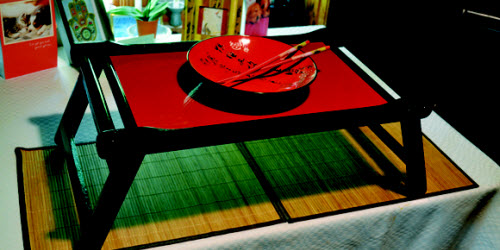As a DIYer, I dislike throwing out useful items that can be rebuilt with a bit of time and effort.
Recently, for example, I almost consigned a foldable serving tray to the landfill because the thin, cheap masonite bottom had broken. As a result, it had fallen out of the grooves in the wood frame that held it in place like a drawer bottom (see picture).
However, after a closer examination of the handy tray, I decided it would be easy to repair by replacing the broken bottom with a sheet of quarter-inch plywood. The frame members were of substantial solid wood and the tray’s design was aesthetically pleasing and functionally clever.
It didn’t take long to disassemble the frame that was held together with pneumatic brad nails and staples. The main challenge was to locate and remove, with needle nose pliers, the small staples that fastened the mortise and tenon joints together.
I did crack one frame member by applying too much force to a staple before I got the hang of the process. Fortunately, it was a clean break and I was able to glue the piece back together with yellow carpenter’s adhesive and two small clamps. (None of the joints had been glued when assembled at the factory, likely a cost and time-saving mass production technique that worked in my favour, as glued joints would have been more difficult to take apart without tearing out wood.)
I used a plunge router with a fence and a quarter-inch carbide bit to enlarge the existing eighth-inch grooves in the frame members to receive the new quarter-inch plywood bottom. To perform this operation safely and accurately, I temporarily screwed the pieces to a solid wood base (see picture). I used eighth-inch wood plugs to hide the screw holes afterwards.
The quarter-inch plywood fit so snugly into the grooves that I used a circular sander to create a slight bevel on the underside edges of the panel to allow it to slide smoothly into the grooves. A tight or forced fit can cause frame members to crack when swelling of the wood occurs in humid conditions.
Though it had been purchased at a big box retailer known for its Nordic designs, I felt the tray exhibited Asian influences, so I decided to finish it with gloss red and black to match an Oriental bowl cherished by my wife. Before reassembly, I painted the individual pieces with two coats of water-based acrylic with a light sanding (320-grit) between to ensure a smooth finish.
I reassembled the tray using yellow glue and small, countersunk brass screws to secure the joints. I covered the screw heads with non-shrinking wood filler, using a small artist’s brush and black acrylic to hide the filler.
Instead of ending its life in a landfill, the rebuilt tray with the bowl placed on the sturdy plywood base has been reborn as an object d’art or, at least, the display platform for a piece of art.



